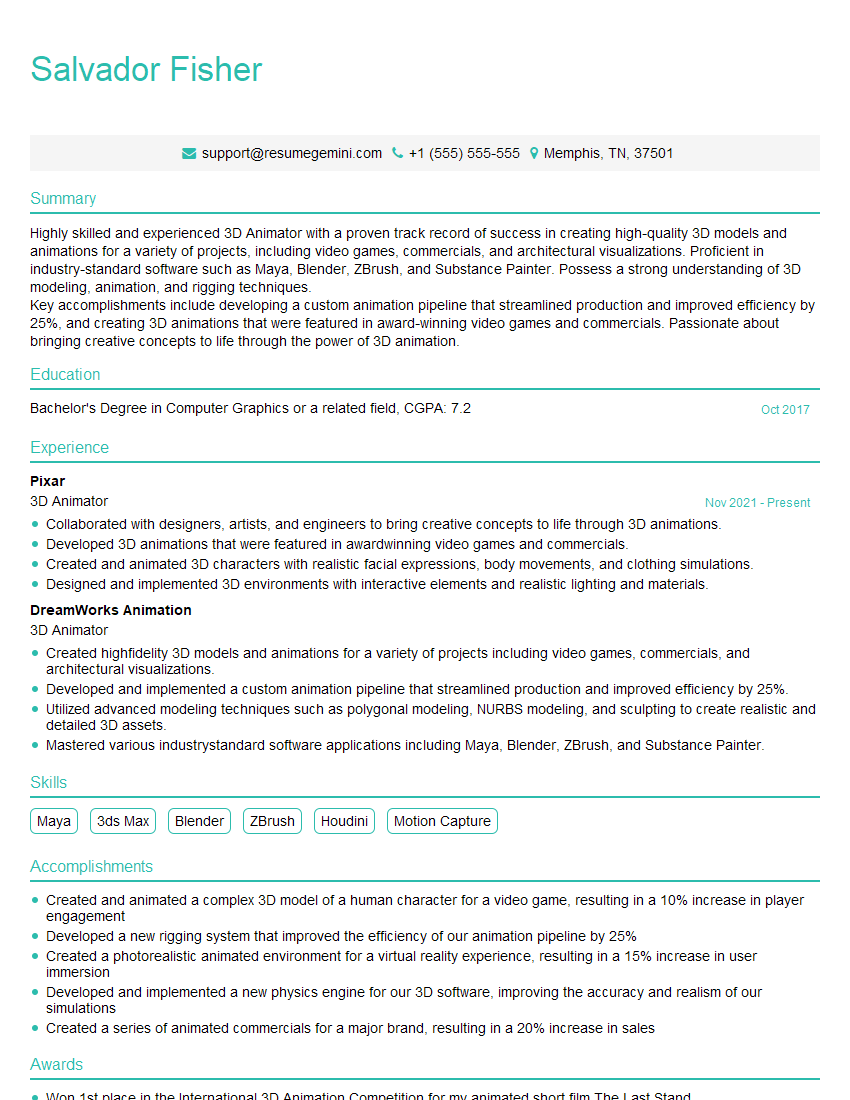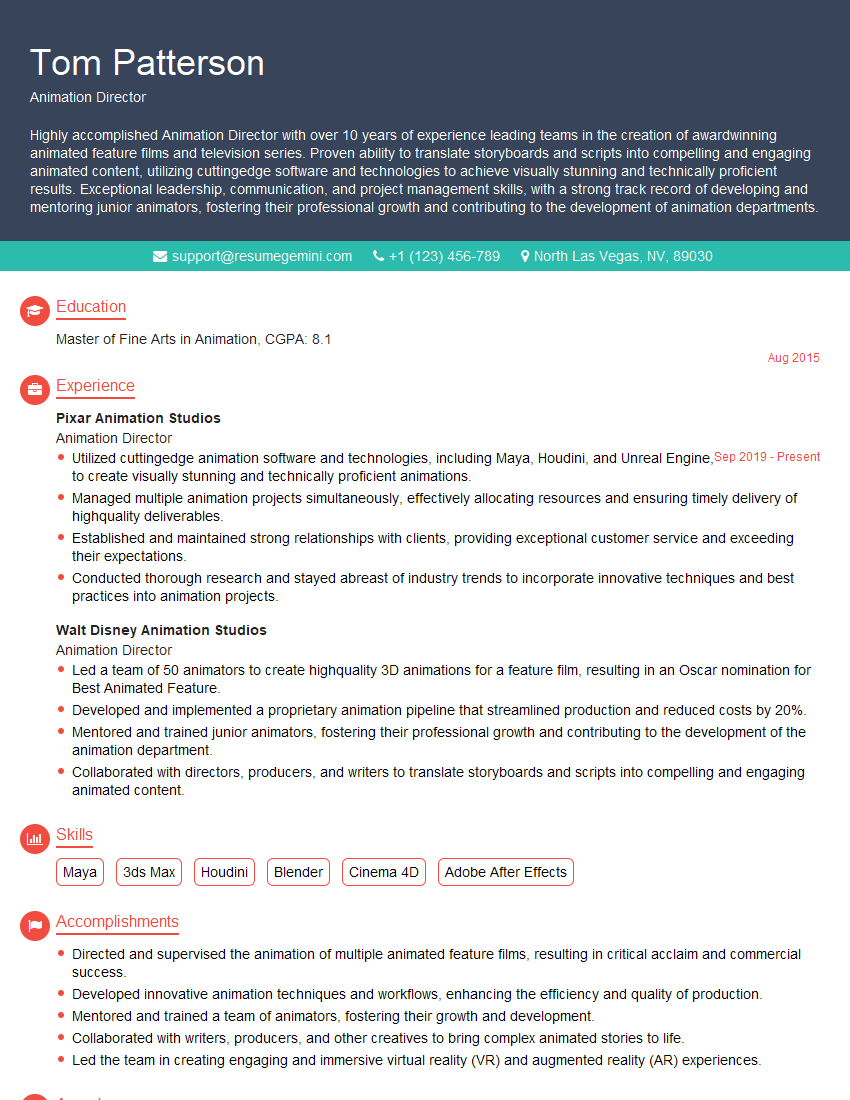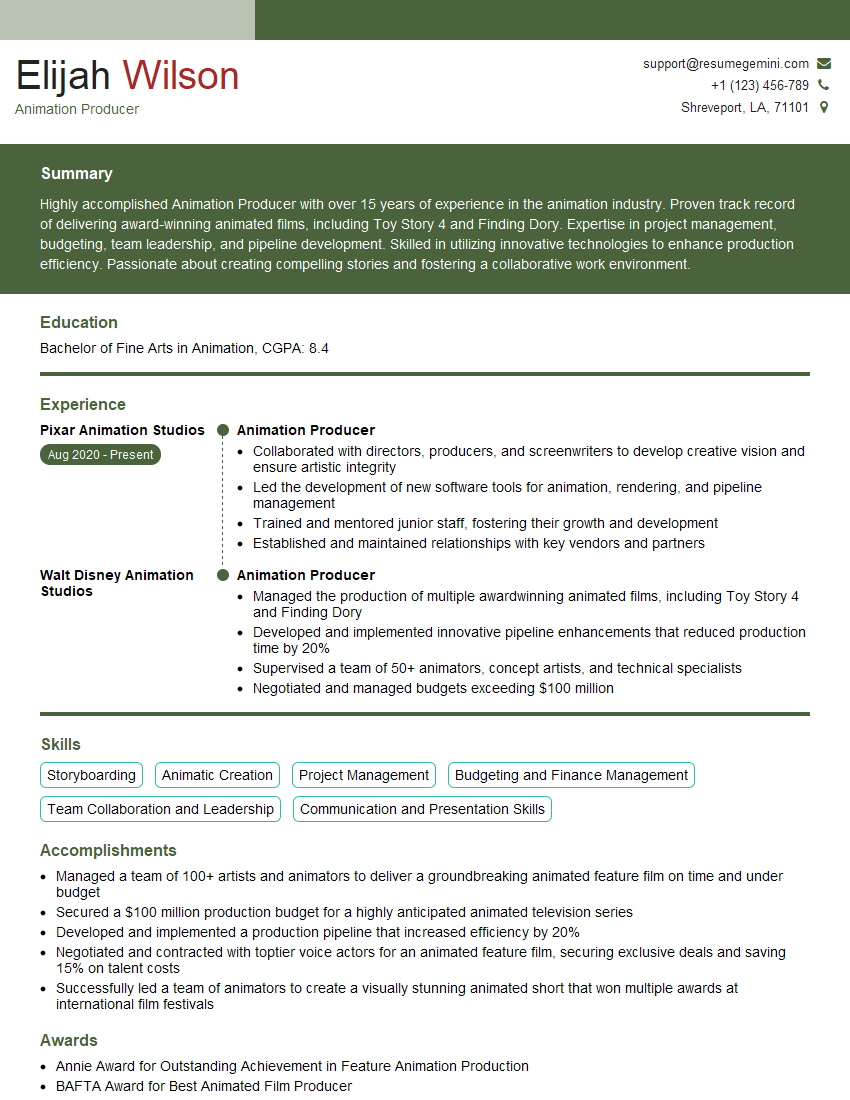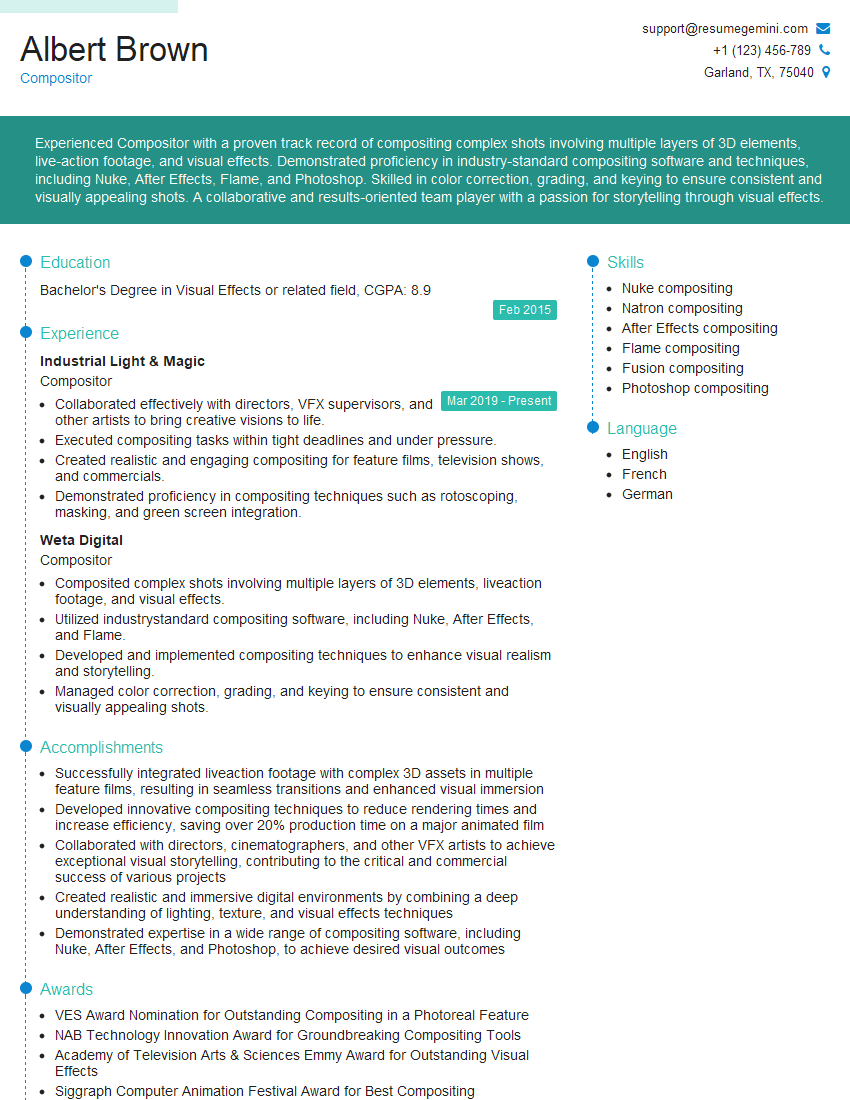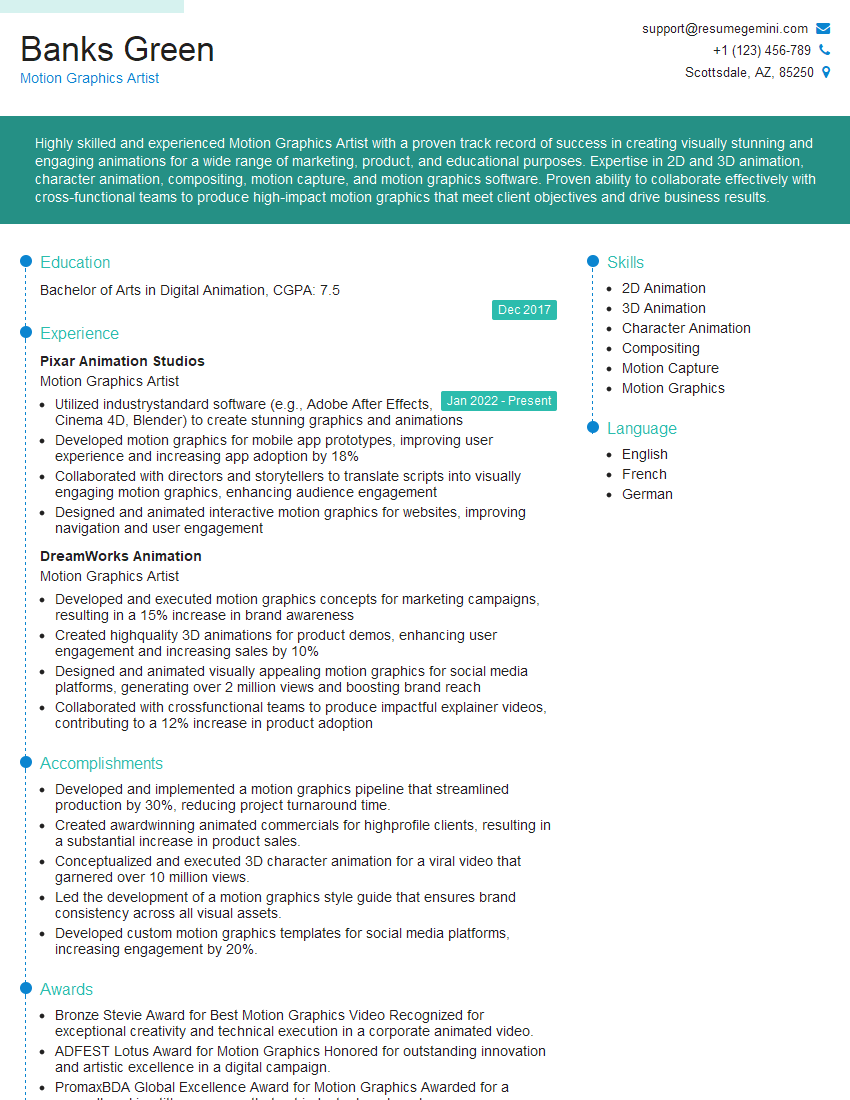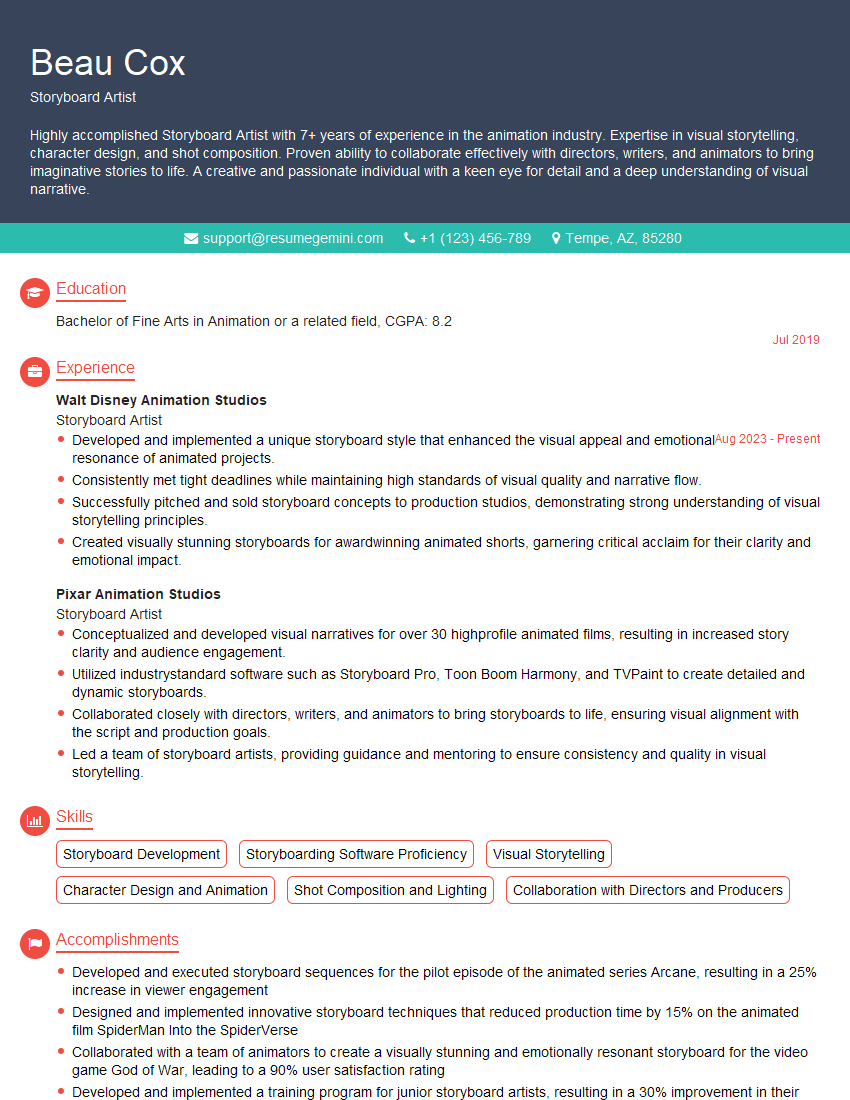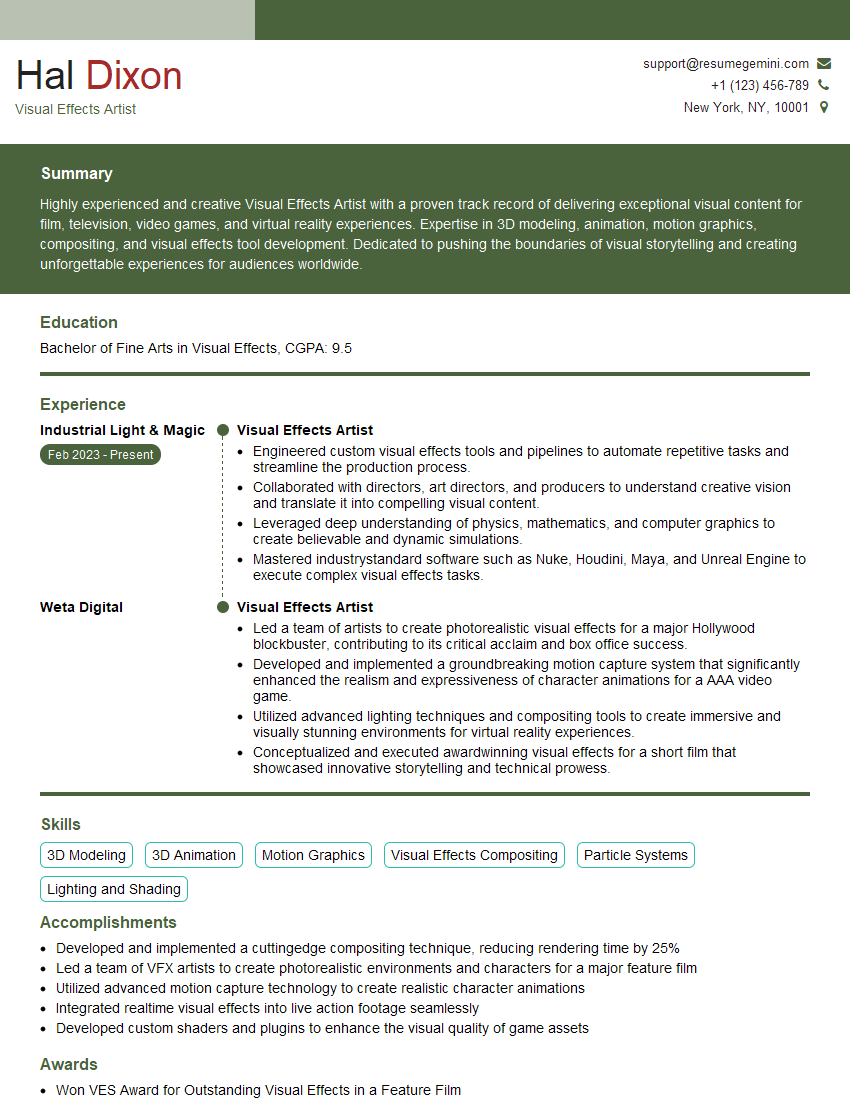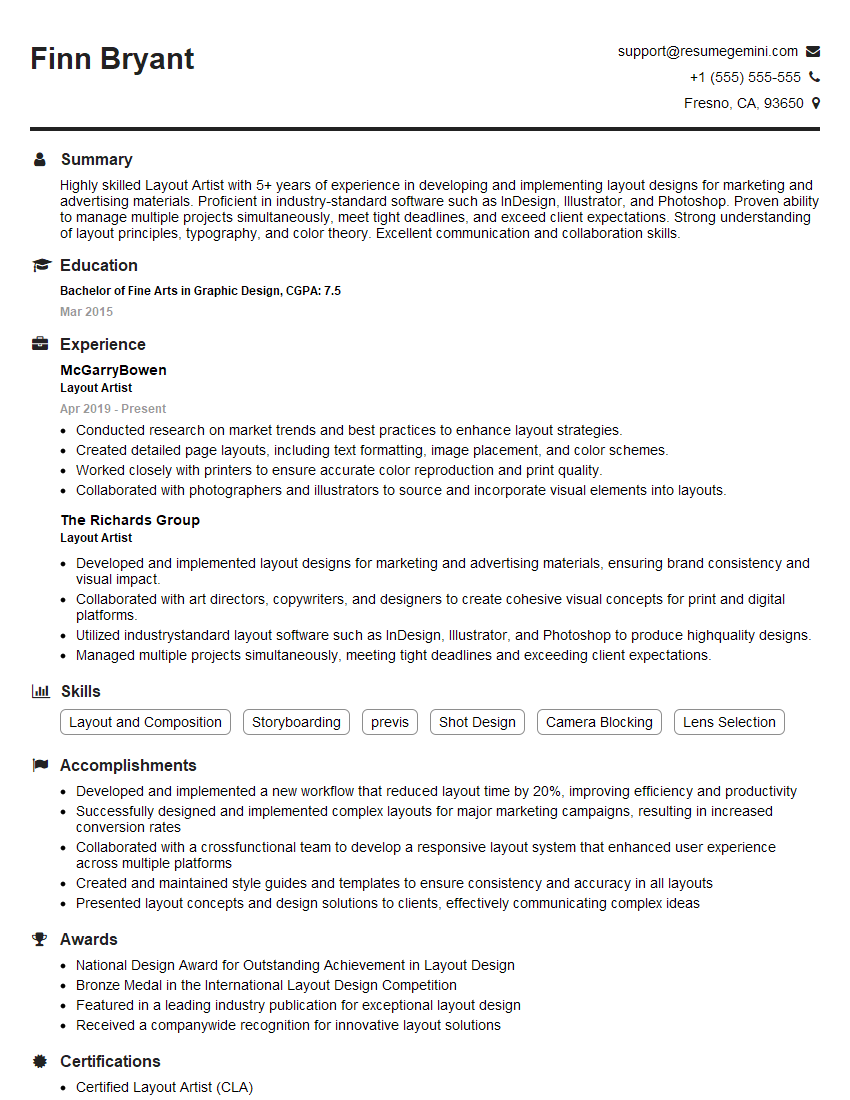Interviews are more than just a Q&A session—they’re a chance to prove your worth. This blog dives into essential Animatic Creation interview questions and expert tips to help you align your answers with what hiring managers are looking for. Start preparing to shine!
Questions Asked in Animatic Creation Interview
Q 1. Explain the difference between a storyboard and an animatic.
Think of a storyboard as a comic book and an animatic as a rough movie trailer. A storyboard is a series of drawings or sketches that visually represent the key shots and actions of a film or animation. It’s a planning tool, focusing on composition, character placement, and camera angles. An animatic, on the other hand, takes those storyboards and brings them to life, albeit in a very rudimentary form. It’s a moving storyboard, using the actual shot timings and often incorporating basic animation or placeholder footage with a basic audio track. The animatic tests the pacing, flow, and overall rhythm of the narrative before significant resources are invested in full animation or live-action production.
For example, a storyboard might show a character walking across a room in three panels, while the animatic would show a moving sequence of those three panels, potentially with placeholder sound effects of footsteps. This allows for a better understanding of the timing and overall feel of the scene.
Q 2. What software are you proficient in for animatic creation?
I’m proficient in several industry-standard software packages for animatic creation. My primary tools are Adobe After Effects and Premiere Pro. After Effects excels in creating motion graphics and visual effects, perfect for adding basic animation to the storyboard images. Premiere Pro’s strength lies in its video editing capabilities; I use it to assemble the animatic, synchronize the audio, and refine the timing. I’m also familiar with Toon Boom Harmony and other animation software, depending on the project’s specific needs. For simpler animatics, I can even utilize readily available tools like PowerPoint or Keynote, strategically combining images with transitions and narration.
Q 3. Describe your workflow for creating an animatic from a storyboard.
My workflow begins with a thorough review of the approved storyboard. I then import the storyboard images into my chosen software (usually After Effects or Premiere Pro). I carefully time each shot, considering the pacing and narrative rhythm. Often I will add basic camera movement or simple animation to enhance visual flow. Then, I bring in placeholder audio – usually voiceover narration, sound effects, and temp music. Once the rough cut is complete, I meticulously review the timing, ensure a smooth transition between shots, and then export it as a high-resolution video file for review.
- Import Storyboards: Import high-resolution storyboard images into After Effects or Premiere Pro.
- Add Basic Animation (Optional): Use After Effects to add subtle animation (e.g., slight camera pans, character movement) for a more dynamic feel.
- Set Shot Timings: Carefully determine the length of each shot, considering the pace and flow of the narrative.
- Add Placeholder Audio: Incorporate temporary voiceover, sound effects, and music to enhance the viewing experience.
- Refine and Export: Review the animatic multiple times, ensuring smooth transitions and accurate timings before exporting a high-resolution video file.
Q 4. How do you handle revisions and feedback on your animatics?
Revisions are a crucial part of the animatic process. I actively solicit feedback from directors and clients. When I receive notes, I organize them systematically, noting the timestamp of each suggested change in the animatic. This allows for precise and efficient implementation of adjustments. I often hold review sessions to discuss changes collaboratively, ensuring everyone is on the same page. The process might involve several iterations until the animatic perfectly reflects the creative vision and story arc. My experience has shown that clear and efficient communication regarding revision handling significantly accelerates the feedback process, leading to better results and more satisfied clients.
Q 5. What are the key elements of a successful animatic?
A successful animatic is clear, concise, and effectively communicates the story’s essence. Key elements include:
- Clear Storytelling: The narrative should be easy to follow and understandable, even without full animation or detailed visuals.
- Accurate Timing and Pacing: The rhythm should match the overall tone and mood of the project.
- Appropriate Audio: Placeholder music and sound effects should enhance the mood and create a cinematic experience.
- Effective Visuals: Even with basic imagery, the visuals should be well-composed and visually interesting.
- Functional Feedback Tool: It should serve as a practical tool for identifying potential story issues and improving the overall narrative before final production begins.
Q 6. How do you incorporate sound and music into your animatics?
Sound and music are critical for setting the mood and enhancing the storytelling impact. I typically use temporary music tracks and sound effects during the animatic creation. For example, I might use royalty-free music that aligns with the overall tone (epic, suspenseful, comedic, etc.). Sound effects are crucial for adding realism and enhancing the viewer’s immersion; even simple placeholder sounds can significantly improve the feel. The audio is synchronized precisely with the visuals, ensuring the timing is perfect and the emotional impact is maximized. It’s important that the temporary audio doesn’t overpower the storytelling but rather complements it, setting the stage for the final audio mix.
Q 7. How do you ensure the animatic aligns with the project’s overall vision?
Maintaining alignment with the project’s overall vision is paramount. I start by having a deep understanding of the project’s goals, style, target audience, and creative brief. During the animatic creation process, I frequently refer back to the initial concept art, mood boards, and any other relevant design documentation. Regular communication with the creative director ensures any potential deviations from the vision are promptly identified and addressed. I strive to use the animatic as a testing ground to identify any discrepancies between the initial concepts and their execution, ensuring that the final product remains faithful to the project’s core vision.
Q 8. Describe your experience with different animation styles and techniques.
My experience spans a wide range of animation styles and techniques, encompassing everything from the simplicity of 2D whiteboard animation, perfect for quick storyboarding and client presentations, to the more complex world of 3D pre-visualization. I’ve worked with both hand-drawn and digitally created animatics, utilizing software like Adobe After Effects, Toon Boom Harmony, and even Cinema 4D for more sophisticated projects requiring 3D models.
For example, on a recent children’s show, we used a charming, slightly rough-around-the-edges 2D style to convey the playful energy of the characters. In contrast, for a high-budget sci-fi film, we employed highly detailed 3D models rendered as animatics to give the director and producers a clear sense of the final product’s visual scope and scale. The choice of style always depends on the project’s needs, budget, and target audience.
- 2D Animation: Excellent for quick turnaround times and lower budgets. Offers flexibility in style and artistic expression.
- 3D Animation: Allows for greater realism and complex camera work, but requires more time and resources.
- Motion Capture (MoCap): Useful for realistic character movements, particularly for human figures. Can be integrated into 3D animatics.
Q 9. How do you manage time constraints and deadlines when creating animatics?
Managing time constraints in animatic creation requires meticulous planning and a flexible approach. It begins with a clear understanding of the project’s scope and timeline. We break down the animatic into smaller, manageable tasks, assigning clear deadlines for each. We prioritize scenes based on their criticality to the narrative. For instance, crucial plot points or emotional climaxes are given precedence.
Regular progress checks and team meetings are essential to identify potential bottlenecks early. I utilize project management software to track progress, assign tasks, and manage resources effectively. If unforeseen delays occur (which happens!), we adapt by prioritizing high-impact sequences and potentially adjusting the scope of less crucial sections. Communication is key – keeping the team and client informed of any changes is crucial to maintain trust and manage expectations.
Think of it like a relay race; each team member has a crucial leg to run, and effective communication ensures a smooth handover and a successful finish.
Q 10. How do you collaborate with other team members during the animatic process?
Collaboration is fundamental to animatic creation. From the start, I actively involve the director, storyboard artists, voice actors, and other relevant team members. Regular feedback sessions are integrated throughout the process. We frequently use cloud-based platforms for sharing files and providing real-time feedback.
For example, the storyboard artist’s input is crucial in determining the visual style and key poses. The director’s feedback guides the pacing, shot composition, and overall narrative flow. Incorporating early voice recordings helps to synchronize the animation with dialogue and ensures a natural rhythm. We even use online tools for real-time collaborative editing of animatics, allowing multiple team members to simultaneously work on the same project.
Effective communication and a shared understanding of the project goals are essential for maintaining consistency and fostering a creative and efficient workflow.
Q 11. How do you troubleshoot technical issues during animatic production?
Troubleshooting technical issues is an inevitable part of animatic production. My approach is methodical and systematic. I first identify the problem precisely – is it software-related, hardware-related, or a data issue? Then, I try common solutions such as restarting the software, checking file paths, and ensuring sufficient system resources. If that fails, I consult online forums, documentation, or support channels related to the specific software we are using.
For instance, if I encounter rendering problems, I would check the render settings, scene complexity, and hardware capabilities. If it’s a software glitch, I may try updating the software or reinstalling it as a last resort. Version control is a vital tool – this ensures that any unforeseen technical problems don’t erase significant portions of the work.
A proactive approach – regular software updates, robust backups, and thorough testing – helps mitigate many potential technical snags.
Q 12. What is your approach to creating compelling character animation in animatics?
Compelling character animation in animatics starts with a thorough understanding of the character’s personality, motivations, and relationships with other characters. I collaborate closely with the character designer and director to capture these aspects. We analyze the character’s arc throughout the story, identifying crucial emotional moments and designing poses and actions that effectively communicate those emotions.
I use a combination of simple animation principles, such as squash and stretch, anticipation, and follow-through, to bring the characters to life. Even though animatics are rough, they can still effectively communicate the essence of character movements. Simple, clear animation often proves far more effective than overly complex movements in a quick-and-dirty animatic.
Consider a scene where a character is surprised. Simple wide eyes, a slight jump, and a quick hand to the mouth can communicate the feeling more effectively than overly detailed, time-consuming animation at this stage.
Q 13. Explain your understanding of pacing and timing in an animatic.
Pacing and timing are crucial for the narrative effectiveness of an animatic. Pacing refers to the speed at which the story unfolds, while timing refers to the duration of individual shots and actions. A well-paced animatic maintains viewer engagement without rushing the story or creating dead spots. Timing impacts the emotional weight of scenes and how well actions align with dialogue or sound effects.
I achieve good pacing and timing by using a combination of techniques: varying shot lengths to emphasize emotional beats, using slow-motion for impactful moments, and employing fast cuts for action sequences. We often use a storyboard timeline as a guide for pacing before animating and refine the timing iteratively based on feedback. A carefully chosen musical track can also serve as a guide for pacing and help establish the overall mood of the animatic.
Imagine a dramatic reveal; a slower pace with longer shots builds suspense, while a fast-paced action sequence uses short, quick shots to convey excitement and urgency.
Q 14. How do you handle complex camera movements in your animatics?
Handling complex camera movements in animatics requires a balance between visual storytelling and technical feasibility. While elaborate camera movements can enhance the viewing experience, they should always serve the narrative and not distract from it. We often use simple keyframes to plan the camera movements, gradually refining the paths as needed.
In software like After Effects, we can easily create smooth camera pans, zooms, and more complex movements using keyframes and easing functions. For very ambitious movements, we might even use pre-visualization software to refine complex shots prior to the animatic creation. However, we prioritize clarity and understanding over visual complexity; the aim is to establish camera shots effectively rather than to create a technically flawless final product.
Remember, the purpose of the animatic is to serve as a clear visual blueprint, not a final product. Complex camera work is beneficial when it aids that purpose; otherwise, simpler camera movements are preferable.
Q 15. How do you use animatics to solve visual storytelling problems?
Animatics are crucial for pre-visualization, allowing us to solve visual storytelling problems before expensive production begins. Think of it as a blueprint for the final film or animation. We use animatics to:
- Identify pacing issues: Are scenes too long or short? Does the narrative flow smoothly? Animatics help pinpoint areas needing adjustment.
- Test scene composition and camera angles: We experiment with different shots and viewpoints to see what works best for conveying emotion and information. For example, a high-angle shot can make a character feel vulnerable, while a low-angle shot can make them appear powerful. We can easily iterate on these aspects in the animatic phase.
- Refine storyboarding: Often, animatics reveal flaws in the storyboard that weren’t apparent initially. The movement and timing in an animatic bring the story to life, revealing gaps or inconsistencies in the narrative.
- Visualize complex action sequences: Animatics are especially useful for visualizing intricate fight scenes, chase sequences, or any scene requiring detailed choreography. We can experiment with different approaches and ensure everything is clear and engaging before committing to the final animation.
- Collaborate effectively: Animatics provide a common visual language for directors, animators, editors, and clients. It’s much easier to discuss and make changes to a moving animatic than to a static storyboard.
Career Expert Tips:
- Ace those interviews! Prepare effectively by reviewing the Top 50 Most Common Interview Questions on ResumeGemini.
- Navigate your job search with confidence! Explore a wide range of Career Tips on ResumeGemini. Learn about common challenges and recommendations to overcome them.
- Craft the perfect resume! Master the Art of Resume Writing with ResumeGemini’s guide. Showcase your unique qualifications and achievements effectively.
- Don’t miss out on holiday savings! Build your dream resume with ResumeGemini’s ATS optimized templates.
Q 16. Describe a time you had to adapt your animatic process due to unexpected challenges.
During a project for a low-budget indie film, we encountered unexpected limitations with our initial chosen software. The software couldn’t handle the level of detail we needed for a key action sequence, causing frequent crashes and rendering delays. We quickly adapted by switching to a simpler, more stable program that, while less feature-rich, allowed us to maintain project momentum. We prioritized functionality over advanced features, focusing on creating a clear, functional animatic. This experience taught me the importance of having backup plans and being flexible when unforeseen technical challenges arise. We also learned to meticulously plan our animatic workflow to anticipate potential hurdles.
Q 17. How familiar are you with industry standard file formats for animatics?
I’m very familiar with industry-standard file formats for animatics. Common formats include:
- QuickTime (.mov): A widely compatible format offering good compression and quality. Often preferred for its ease of sharing and playback across different platforms.
- AVI (.avi): While older, AVI remains usable, though often less efficient in terms of file size compared to modern codecs.
- MP4 (.mp4): Another highly versatile format, providing good balance between file size and quality. It’s increasingly becoming the standard for animatics.
- H.264/MPEG-4 AVC: This is a video compression standard used in many formats (including MP4) which offers excellent quality and compression, a key consideration for animatics, often involving large files.
Choosing the right format depends on factors like final use, required quality level, and compatibility with the intended recipients and software.
Q 18. What is your experience with creating animatics for various media (film, TV, games)?
My experience spans various media. I’ve created animatics for feature films, television series, commercials, and video games. Each medium requires a slightly different approach. For instance:
- Film: Animatics often need to be highly polished and detailed to accurately convey the director’s vision for complex shots and camera movements. This can often involve more sophisticated software and a higher level of refinement.
- TV: The approach is often faster paced and more streamlined due to production schedules and budgets. The focus is on conveying the story clearly and efficiently.
- Games: Animatics need to not only tell the story but also demonstrate the game’s mechanics and user interface. Often, simple placeholder assets will suffice, and focus is placed on the overall gameplay flow and scene transitions.
Adapting my style and workflow to the unique requirements of each medium is crucial to delivering effective animatics.
Q 19. How do you ensure your animatics are visually engaging and maintain viewer interest?
Creating visually engaging animatics requires careful consideration of several elements:
- Dynamic pacing: Avoid monotonous rhythm. Vary the shot length, camera angles, and movement to keep the viewer interested.
- Strong composition: Use leading lines, rule of thirds, and other compositional techniques to create visually appealing frames. This ensures that shots are not only functional but also aesthetically pleasing.
- Clear storytelling: Make sure the narrative is easy to follow. Employ clear visual cues and avoid ambiguous scenes.
- Appropriate style: The animatic style should reflect the overall tone and aesthetic of the project.
- Effective use of sound: Adding placeholder sound effects and music can significantly improve viewer engagement. This contextualizes the visual information and enhances the emotional impact.
A well-crafted animatic should serve as a captivating preview of the final product, not just a technical roadmap.
Q 20. How do you handle feedback from directors, producers, or clients?
Handling feedback effectively is critical. I approach it as a collaborative process. I start by actively listening to the feedback, clarifying any uncertainties. Then, I meticulously document all comments, categorizing them by urgency and impact. This allows me to prioritize changes strategically, considering budget and schedule constraints. I often create annotated versions of the animatic to visually showcase proposed changes, making the feedback process more transparent and efficient. Finally, I provide a revised animatic that addresses the most important feedback, communicating clearly why certain suggestions might have been implemented partially or not at all.
Q 21. How do you balance artistic vision with technical constraints in animatic creation?
Balancing artistic vision and technical constraints is a constant juggle. Sometimes, a breathtakingly ambitious shot might be technically impossible or prohibitively expensive to render in the final product. I address this by:
- Early communication: Openly discussing the technical limitations with the team early in the process. This helps manage expectations and find creative workarounds.
- Prioritization: Focusing resources on the most crucial scenes, ensuring the core message and emotion are effectively communicated.
- Simplification: If necessary, simplifying complex shots without compromising the overall narrative clarity.
- Iterative refinement: Working iteratively, gradually refining the animatic while testing feasibility and staying within the constraints.
The goal is to achieve a visually stunning animatic that’s also realistic and achievable given time, budget, and technical limitations.
Q 22. What are some common mistakes to avoid when creating animatics?
Common mistakes in animatic creation often stem from a lack of planning or understanding of the animatic’s purpose. It’s a crucial pre-visualization tool, not a polished final product. Here are some key pitfalls to avoid:
- Poor Storyboarding: A weak storyboard is the foundation of a weak animatic. Ensure your storyboard clearly communicates the action, emotion, and pacing. Think of it as a detailed script, visually expressed.
- Neglecting Timing and Pacing: Animatics are all about timing. Rushing through important scenes or dragging out less crucial ones can derail the entire narrative flow. Carefully plan your timing and stick to it during creation.
- Ignoring Camera Movement: Effective camera movement is key to storytelling. Failing to plan camera angles, movement, and transitions can result in a disjointed and confusing final product. Consider the impact of each camera shot on the viewer’s experience.
- Overly Detailed Animation: Remember, the animatic is a rough draft. Focusing too much on detailed animation detracts from the story and wastes valuable time. Keep it simple and focus on conveying the core action and emotion.
- Lack of Collaboration: Animatics are collaborative efforts. Failing to solicit and incorporate feedback from directors, producers, and other team members can lead to misinterpretations and costly revisions later in the pipeline.
For example, I once worked on a project where the initial animatic lacked clear camera direction. This led to significant confusion during the subsequent animation phase, resulting in costly re-shoots and delays. Learning from this, I now emphasize the importance of pre-visualizing camera movements and angles in detail during the animatic stage.
Q 23. How do you stay up to date with current trends and technologies in animatic creation?
Staying current in the dynamic field of animatic creation involves a multi-pronged approach. I actively engage in several strategies to ensure my skills and knowledge remain sharp:
- Industry Publications and Websites: I regularly read industry publications and websites dedicated to animation, VFX, and filmmaking. These resources often feature articles on emerging technologies and trends, software updates, and best practices.
- Conferences and Workshops: Attending industry conferences and workshops provides invaluable opportunities to network with fellow professionals, learn about the latest tools, and discover innovative techniques. Directly engaging with experts in the field is an excellent way to stay informed.
- Online Courses and Tutorials: Numerous online platforms offer high-quality courses and tutorials on various aspects of animatic creation, from software proficiency to storytelling techniques. These resources are constantly updated to reflect the latest trends.
- Software Updates and Community Forums: Staying up-to-date with the latest software releases and participating in online forums dedicated to animation software are crucial. Forums allow me to discuss challenges and learn from others’ experiences. Software updates frequently introduce new features and workflows that can significantly improve efficiency and creativity.
- Experimentation and Practice: Continuous experimentation with new techniques and software features is key. I frequently work on personal projects to practice and explore innovative approaches to animatic creation.
Q 24. Describe your experience with version control and asset management in animatic projects.
Version control and asset management are fundamental to successful animatic projects, especially when working on large-scale productions with multiple artists. My experience includes utilizing both centralized and decentralized systems depending on the project’s needs.
- Centralized Systems (e.g., Perforce, Shotgun): These are particularly useful for larger teams, enabling seamless collaboration, tracking revisions, and maintaining a single source of truth for all project assets. This eliminates confusion and ensures everyone is working with the latest approved versions.
- Decentralized Systems (e.g., Git, with appropriate asset management tools): While less common for purely visual assets like animatics, Git can be advantageous for managing scripts, storyboards, and other associated text-based documents. Pairing this with cloud storage for the actual animation files creates a robust system.
- Asset Naming Conventions and Organization: A clear and consistent naming convention for all files and assets is crucial for easy identification and retrieval. This involves employing a systematic approach that helps track individual components and their versions.
- Regular Backups: Regular backups are essential to protect against data loss. I always implement a robust backup strategy, incorporating both local and cloud-based solutions.
In one project, we used Shotgun to manage all assets and track revisions. This streamlined the collaborative process and ensured that everyone was working with the most up-to-date version of the animatic, minimizing conflicts and confusion. The result was a smoother workflow and a significant reduction in wasted time.
Q 25. How would you approach creating an animatic for a complex scene with multiple characters and actions?
Approaching a complex scene with multiple characters and actions requires meticulous planning and a phased approach. My strategy involves breaking down the scene into manageable segments and focusing on clear communication of the core action.
- Detailed Storyboarding: I begin with an extremely detailed storyboard, meticulously outlining each character’s actions, their interactions, and the overall flow of the scene. Each panel should clearly depict the key moments.
- Simplified Character Design: For the animatic, I use simplified character designs. The focus should be on the movement and interaction rather than intricate details. Simple shapes and silhouettes can be extremely effective.
- Breakdown into Key Poses and Actions: I break down the scene into key poses and actions, focusing on the essential movements that convey the narrative. This allows me to focus on the core moments without getting bogged down in unnecessary details.
- Prioritize Readability: Clarity is crucial. Use clear and concise visual language to avoid any ambiguity. Experiment with different camera angles and perspectives to improve scene readability.
- Iterative Refinement: The process is iterative. I review the animatic with the team, get feedback, and make adjustments as needed. This allows for collaborative refinement and ensures the final product effectively communicates the scene’s intent.
For instance, when creating an animatic for a fight scene, I might break it down into individual beats: the initial confrontation, the exchange of blows, the climax, and the resolution. This allows for focused work on each element before assembling the whole scene.
Q 26. What are your strengths and weaknesses as an animatic artist?
As an animatic artist, my strengths lie in my ability to clearly communicate visual stories, collaborate effectively, and deliver high-quality work within tight deadlines. I am adept at using industry-standard software and possess a strong understanding of storytelling principles. My weakness is occasionally getting caught up in detail, and I’m actively working to improve my ability to prioritize and maintain a focus on the overall storytelling objectives within the constraints of the animatic format.
I find that employing time-management techniques and regularly reviewing the overall goals of the animatic helps mitigate this weakness.
Q 27. How do you ensure the animatic effectively communicates the story and emotions?
Ensuring the animatic effectively communicates story and emotion involves careful consideration of several key elements. It’s about creating a visceral experience even with limited detail.
- Clear Visual Storytelling: The animatic must clearly convey the narrative arc, even in its simplified form. The action needs to be easy to follow and the relationships between characters apparent.
- Strategic Use of Camera Angles and Movement: The camera is a powerful storytelling tool. I use camera angles and movement to emphasize emotions, guide the viewer’s eye, and create dramatic effect.
- Timing and Pacing: Precise timing is crucial for conveying emotion. Fast-paced scenes can convey excitement, while slow, deliberate movements can suggest tension or suspense.
- Sound Design and Music: Even simple sound effects and a basic music track can significantly enhance the emotional impact of the animatic. These elements greatly augment the overall feeling of the scene.
- Character Animation: Though simplified, character animation plays a key role. Subtle movements and expressions can effectively communicate emotions and motivations.
For example, a scene depicting sadness might use slow camera movements, muted colors, and downcast character expressions. Conversely, an action sequence would use rapid cuts, dynamic camera angles, and energetic character animation.
Q 28. Describe your process for exporting and delivering final animatics.
My process for exporting and delivering final animatics involves several key steps to ensure compatibility and maintain the quality of the work.
- Choosing the Right Format: The chosen format depends on the intended use. Common formats include QuickTime (.mov), AVI, or MP4. I consider factors like resolution, codec, and file size when making this selection. High-resolution formats are essential for review on large screens, while smaller sizes facilitate easier sharing and transfer.
- Compression Settings: Optimizing compression settings is critical. High-quality compression maintains image clarity while minimizing file size. I avoid excessive compression that could result in artifacts or a loss of visual quality.
- Metadata and Labeling: I always include accurate metadata, such as project name, version number, and date. This ensures easy identification and organization of the files. Clear labeling prevents confusion.
- Multiple Versions: I generally deliver multiple versions of the animatic, such as a high-resolution version for internal review and a compressed version for client sharing. This caters to various needs and viewing platforms.
- Delivery Method: Delivery methods range from cloud storage services (e.g., Dropbox, Google Drive) to direct file transfers. The method depends on the client’s preferences and the size of the file. Large files often require dedicated file transfer services.
Before delivering the final animatic, I always conduct a thorough final review to ensure that the quality is consistent with the project standards and client expectations. This ensures a professional and polished final deliverable.
Key Topics to Learn for Animatic Creation Interview
- Storyboarding Fundamentals: Understanding the principles of visual storytelling, shot composition, and panel layouts crucial for effective animatics.
- Software Proficiency: Demonstrating practical skills in industry-standard software like Adobe After Effects, Toon Boom Harmony, or similar tools used for animatic creation. Be prepared to discuss your experience with different software and workflows.
- Timing and Pacing: Mastering the art of conveying rhythm and emotion through the timing of shots and transitions in your animatic. Discuss how you approach pacing decisions based on narrative needs.
- Collaboration and Communication: Highlighting your ability to effectively collaborate with directors, animators, and other team members. Be prepared to discuss your communication style and problem-solving techniques in a collaborative environment.
- Technical Aspects: Understanding video codecs, resolution, frame rates, and other technical considerations relevant to animatic creation and production pipelines. Show you can troubleshoot technical issues.
- Workflow Optimization: Demonstrating an understanding of efficient workflows to manage large projects and meet deadlines. Prepare examples of how you improve efficiency in your work.
- Revisions and Feedback: Showcasing your ability to incorporate feedback effectively and iterate on your animatic based on directorial notes and client input.
- Different Animatic Styles: Understanding the various styles of animatics, from rough sketches to highly polished versions, and when each style might be appropriate.
Next Steps
Mastering animatic creation opens doors to exciting opportunities in animation, film, and game development. A strong portfolio showcasing your skills is essential, but equally crucial is presenting yourself effectively through a well-crafted resume. An ATS-friendly resume, optimized for Applicant Tracking Systems, significantly increases your chances of getting noticed by recruiters. We highly recommend using ResumeGemini to build a professional and impactful resume tailored to the Animatic Creation field. Examples of resumes optimized for animatic creation roles are available to help guide you.
Explore more articles
Users Rating of Our Blogs
Share Your Experience
We value your feedback! Please rate our content and share your thoughts (optional).
What Readers Say About Our Blog
Hello,
We found issues with your domain’s email setup that may be sending your messages to spam or blocking them completely. InboxShield Mini shows you how to fix it in minutes — no tech skills required.
Scan your domain now for details: https://inboxshield-mini.com/
— Adam @ InboxShield Mini
Reply STOP to unsubscribe
Hi, are you owner of interviewgemini.com? What if I told you I could help you find extra time in your schedule, reconnect with leads you didn’t even realize you missed, and bring in more “I want to work with you” conversations, without increasing your ad spend or hiring a full-time employee?
All with a flexible, budget-friendly service that could easily pay for itself. Sounds good?
Would it be nice to jump on a quick 10-minute call so I can show you exactly how we make this work?
Best,
Hapei
Marketing Director
Hey, I know you’re the owner of interviewgemini.com. I’ll be quick.
Fundraising for your business is tough and time-consuming. We make it easier by guaranteeing two private investor meetings each month, for six months. No demos, no pitch events – just direct introductions to active investors matched to your startup.
If youR17;re raising, this could help you build real momentum. Want me to send more info?
Hi, I represent an SEO company that specialises in getting you AI citations and higher rankings on Google. I’d like to offer you a 100% free SEO audit for your website. Would you be interested?
Hi, I represent an SEO company that specialises in getting you AI citations and higher rankings on Google. I’d like to offer you a 100% free SEO audit for your website. Would you be interested?
good
